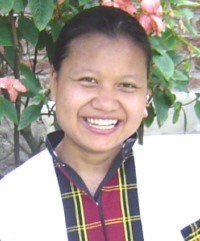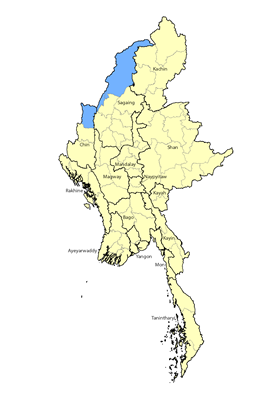Identifying Gangte as a specific group in Myanmar is problematic, as linguists do not recognize their language apart from its close relationship to Saizang, Thado, and Zo. The Gangte retain a proud ethnic and cultural identity, however. Across the border in India, the Gangte enjoy recognition as one of that country's Scheduled Tribes, with Gangte youth and cultural associations actively promoting their culture.
Location: The Gangte tribe numbers more than 30,000 people spanning both sides of the Myanmar-India border. The majority (24,000) live in northeast India, particularly in 37 villages within the state of Manipur. Others live in Assam, Nagaland, and Tripura. In Myanmar, the 6,600 Gangte people inhabit the Kabaw Valley in Chin State's Tedim District, while some also spill over into three districts of southern Sagaing Region.
Language: The Gangte people in Myanmar speak a Northern Chin language related to Tedim and several other Tibeto-Burman varieties. In India, their language is under pressure from the dominant Meitei language in Manipur.
The name Gangte was originally a term “employed to denote the children of a remote ancestor, Tukgek. As they once lived in the Gang Valley, somewhere in Myanmar, they came to be known as Gangte (people of the Gang Valley).” For much of their history, the Gangte have been respected as brave warriors who never take a backward step. In recent years many of the tribes in Manipur, including the Gangte, have been subjected to ethnic cleansing by the dominant Hindu Meitei people. Since 2022, clashes over land rights led to hundreds of people being killed and women and girls raped.
Traditionally, when a young Gangte man wanted to marry, his parents visited the girl's home, taking with them a jar of rice beer. If the proposal was not accepted, the girl's parents would give a jar of beer in return and send them on their way. On the wedding day, the groom would send an advance party to fetch the bride. On their arrival at the girl's village, “wrestling between the boy's party and the girl's party ensued. Strong and expert wrestlers from both sides were selected, but the boy's side would allow the girl's side to take the upper hand. It was considered that the boy had already won the competition by winning the hand of the girl in marriage, therefore her side should be allowed to win the wrestling as a consolation.”
For centuries the Gangte were animists, offering sacrifices to placate spirits that could wreak havoc on their communities. Fear of demons affected every area of their lives. For example, if a newborn baby was not immediately given a name, “thita (evil spirits) would do so, resulting in ill health or short life for the child.”4 In Manipur, the North-East India General Mission spearheaded Christian work among the Gangte and other tribes in the area. Progress was slow until the aftermath of the so-called Kuki Rebellion that occurred between 1917 and 1919, when the British subdued and disarmed the tribes.5 This military defeat “was more than a defeat at arms. It was a defeat of the old way of life, and large numbers of people began to turn towards Christianity. The Gospel of Christ brought a welcome word of peace and brotherhood to a people so recently ravaged by war.”
Today, Jesus Christ has conquered the hearts of the Gangte people. In India, over 20,000 Gangte people (96 percent of their population) declared they were Christians in the 2011 census. On the Myanmar side of the border, many Gangte are also strong Christians, although animistic beliefs persist in some communities, especially those living in the Sagaing Region. Although the Gangte New Testament was published in 1959 and the full Bible in 1991, it is primarily only available and used on the Indian side of the border.
Scripture Prayers for the Gangte in Myanmar (Burma).
| Profile Source: Asia Harvest |












